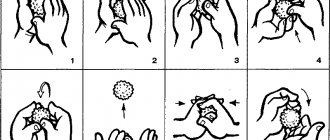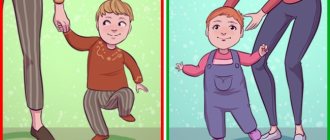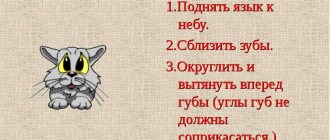No person is immune from colds and runny noses, especially small children. And parents are often at a loss when a baby with a stuffy nose cannot blow his nose. Meanwhile, mucus filling the nose not only looks unsightly, but can also aggravate health problems. How to teach a baby to blow his nose? How to do this correctly and get a preschooler interested in the process?
- 2 At what age can you teach a baby to blow his nose?
- 3 How to motivate your child to learn to blow his nose
- 4 How should a child blow his nose correctly?
4.1 Video: Dr. Komarovsky teaches how to properly clear your nose
- 4.2 Video: cartoon where a boy learned to blow his nose and recovered
Causes of a runny nose and crusts in the nose
A runny nose is a phenomenon when the nasal mucosa becomes inflamed. The cause may be colds, acute respiratory viral infections, allergies, but not necessarily. At first glance, a child may be absolutely healthy, but the nose reacts to an infection in the air at home (if a parent, brother or sister is sick). The mucous membrane, performing a protective function, absorbs bacteria, and as a result, liquid whitish discharge appears. It seems that they do not interfere much, but they are a favorable environment for the development of microbes, the growth of which leads to a prolonged runny nose and other diseases.
The cause of irritation in the nose and the appearance of crusts can be too dry air in the apartment. A runny nose and swelling of the nasopharynx are also symptoms of allergies. Finally, very often teething is accompanied by a runny nose with viscous, light or clear discharge.
All these types of runny nose prevent the child from breathing fully, in addition, they disrupt the normal functioning of the nose, which quickly freezes in the cold, causing discomfort, and are also an excellent breeding ground for pathogenic microorganisms.
Why is it important to teach how to blow your nose?
Blowing your nose is not an innate skill, just like sneezing or coughing. The baby will have to be taught to clean his nose on his own.
And the point is not only that in polite society it is not customary to sneak around. Or because snot dried under the nose does not look aesthetically pleasing. Teaching a child to blow his nose is also important for medical reasons.
Why is a stuffy nose dangerous?
- Infection with ARVI begins in the nasal cavity. One of the first symptoms of the disease is nasal discharge. If you do not remove them, but draw them in, the infection will spread to the throat much faster. And then it gets to the bronchi and lungs.
- Snot flowing down the nasopharynx irritates the mucous membrane and provokes coughing attacks.
- Stagnation of secretions in the nose makes breathing difficult. The child breathes through his mouth, which provokes the development of tonsillitis or inflammation of the adenoids. This significantly complicates the baby’s condition and delays recovery.
- Prolonged presence of thick mucus in the sinuses provokes the development of otitis media.
- The general condition of the sick child worsens. He becomes even more lethargic and weak due to lack of oxygen.
With a severe runny nose, the skin under the nose becomes irritated. Redness and crusts appear. The child experiences discomfort and does not allow his parents to wipe his nose.
The skill of blowing your nose independently is also useful in emergency situations. If a child gets a foreign body in his nose, he can “blow it out” himself.
But you can resort to similar methods if you are 100% sure that the little one will blow his nose and not suck in air.
What are the consequences of irregular nose blowing?
Mucus that is not removed from the nasal passages in a timely manner leads to negative consequences and various complications:
- The mucous fluid flowing into the nasopharynx irritates it, causes coughing, and can even get into the windpipe, this is especially dangerous for infants.
- Microbes living in mucus can cause inflammation of the throat and nasopharynx, tonsillitis.
- The skin under the nose constantly becomes wet, irritated, red and very painful. Often babies cry in pain when their parents try to touch their nose with a handkerchief.
- Stagnant mucus poses a threat of a serious complication - otitis media.
- Nasal breathing disorder leads to a deterioration in the child’s general well-being, due to the fact that the body does not receive enough oxygen.
- Improper nasal hygiene leads to chronic inflammation of the mucous membrane and the further development of adenoiditis in children, and sinusitis in children 4 years of age and older.
Prolonged sniffing is not only not very attractive, but also unsafe for the child.
As a rule, small children do not purposefully draw in mucus; it does not matter to them whether it comes out or falls into the throat. As early as one year old, you can support your child with praise when he exhales sharply to clear his nose. Some children at this age have already fully mastered the skill of blowing their nose. For this, the mucus must be quite liquid (you can soften it with saline solution).
If mucus stagnates in the nose, provokes inflammation of the throat, and it is not possible to remove it (drops do not help, the child does not know how to blow his nose), you should contact a pediatric otolaryngologist. He will rinse the nasal passages with a special preparation.
How to blow your baby's nose?
The baby needs to be taught how to blow his nose correctly. But what to do if a very young child gets sick? Most children do not immediately manage to master this difficult science, and no one is immune from diseases. Therefore, parents will have to blow their child’s nose for some time until he begins to cope with this procedure on his own.
Obviously, there is no way to teach a baby to blow his nose. He is still too small and not capable of such complex manipulations. To rid a small nose of snot:
- Soften the mucus by dripping saline into both nostrils - this will make it easier to remove snot;
- Use an aspirator to remove mucus;
- Wipe your baby's nose with a soft cloth;
- Repeat the procedure periodically as needed.
It's best to forget about classic fabric handkerchiefs. They accumulate microbes that, upon contact with the mucous membrane, penetrate the body. It is advisable to use disposable paper napkins. The nose should not be wiped, but blotted, to avoid irritation of the delicate baby skin.
The advice on how to blow the snot of a 1-year-old child looks roughly the same. It is unlikely that parents will be able to teach such a baby to blow his nose himself, so the aspirator will be used again.
How to Safely Clean Your Baby's Nose
Very young children have their snot sucked out with special aspirators, which come in different types. The simplest one is a syringe aspirator, a small rubber bulb with a soft silicone tip. A mechanical nasal aspirator has the form of a tube that is inserted into the nose, the suction force is adjustable. There are electronic aspirators. The tip is brought to the child’s nostril and the button is pressed.
To clean a newborn's nose, use cotton swabs soaked in Vaseline. Mucus must be removed carefully without damaging the mucous membrane. Pre-moisten the mucous membrane with saline or the preparation “Aqualor”, “Aquamaris”, to do this you need to carefully drip no more than 2 drops, wait 2 minutes. After this preparation, the crusts soften and are easily removed.
To clean the nose of dust, small foreign particles and treat a runny nose, you can rinse the nasal passages with saline or ready-made saline solution. The procedure is performed with a special aerator, or a syringe or syringe.
When is the best time to start training?
There is no single standard for what time to start teaching your baby how to properly clear his nose. This is completely individual for each child. Sometimes a one and a half year old baby can master the technique of blowing his nose, but a three year old child has difficulties.
The optimal age for training is two years and older. This is due to the increased desire of a two-year-old toddler to copy the behavior of others. It is best to build the learning process in a playful way. You shouldn’t tell a 2-year-old child about the structure of the nasal passage and possible complications, just play with him.
If a child refuses a lesson, he cannot be forced. Don't rush, give it a try in three years. At this age, the learning process will become easier, you can talk about more complex things, for example, why the nose gets sick, how to help it. Children aged 3 are able to perceive more complex information if it is presented correctly. By the age of 4–5 years, all children master the technique of blowing their nose.
When to start teaching your child to blow his nose
The answer to the question is ambiguous. It is not easy for very young children to master these new actions, so you can start trying at about 2 years old. Although some children begin hesitant attempts to blow their nose much earlier.
Advice The beginning of training should occur at a time when the baby is in a cheerful mood and body. When you feel unwell, it is difficult to concentrate in class due to a bad mood. Therefore, it is better to start learning before the cold season sets in, when children often get sick.
Don't get angry if the baby doesn't succeed. The main task is to ensure that your actions do not cause a negative attitude, so be more patient. Over time, the result will be achieved. By the age of four, most children can blow their nose.
What if the baby doesn't want to blow his nose?
Remember everything and the mythical children of mothers from forums or groups on VK immediately learn. But real children need time. Moreover, its different quantities for mastering any new skills.
Ignore all the amazing stories about Petya, who himself blew his nose, walked, ate and read poetry a year.
If your baby absolutely does not want to blow his nose, do not put pressure on him. Take pauses in learning, come up with new ways to arouse your child’s interest in the process. The main thing is to be patient.
Let's start studying: two proven ways
You can instill any skills in your child by leading by example or conducting lessons in a fun way. Some children understand explanations well. The child must be made to realize that the air needs to be blown out, and not forced into itself.
Personal example
Try to interest your baby to imitate you. Take a tissue and blow your nose expressively. Now it is the student's turn. The so-called “brudershaft” nose blowing often turns out to be very effective, since together it is much more fun.
Comic game
If teaching by example does not bring noticeable results, it is worth trying turning training into a fun game. After all, kids are ready to play around the clock. Your task is to develop in your child the skill of blowing air through his nose.
- "Snorting hedgehog." Children from the age of one and a half years old love to reproduce how a dog, pussy and other animals “speak”. They already know from you how a hedgehog snorts. Play hedgehogs, ask your baby to snort energetically through her nose, then you can try to cover first one nostril with your finger, then the other.
- "Locomotive". Tell your child that he has turned into a train and gone to distant lands. Think of a child's nose as a chimney releasing steam. Close one “pipe” with it, and blow and puff hard into the other. While doing the exercise, the child will gradually learn to blow his nose with one and the other nostril. This will help clear your nose if you have a severe runny nose.
- "Flying papers." To play, you need to cut thin paper or napkins into small pieces and collect them in a pile on the table. Take turns with your child to blow on the pile of pieces of paper with your nose. Whoever blows the most pieces of paper onto the floor wins. We advise, despite the course of the game, to let the child win and rejoice at his success. This is to your advantage, because a kid who is passionate about the game will sincerely strive to win, and at the same time, the likelihood of quickly learning to blow his nose will increase.
- “Blow out the candle.” At 3 years old, a child can participate in a traditional game of learning to blow air through the nose. Of course, you cannot leave him alone with a burning candle, but under your close attention this is not dangerous. Ask your child to blow out the fire by exhaling from the spout. The baby will try. Yes, a burning candle cannot be compared with a simple piece of paper, it is very exciting.
- "Let's fuck together." The smallest child can say loudly and expressively: “Ew!” Then ask the baby to repeat. As soon as he joins the game, you need to repeat “Ew!”, but this time connecting your nose to the blowing. Your goal is to encourage your baby to blow air through his nose.
- "Football". You need to put a small piece of cotton wool on the table and sit with the baby opposite each other. Well, shall we play? Score a goal for me!
How to motivate your child to learn to blow his nose
Since the methods of teaching nose blowing will mostly be playful, they themselves will be motivation for the child. In addition, a parent with imagination can come up with a whole magical story for the child, which will encourage him to practice an important skill. Options could be, for example:
- "Save the Zoo." The mother tells the child that there was a fire at the zoo and only he can save the animals. To do this, you need to drop saline solution into the spout, and then blow out balls into which the animals will be placed. They will fly into the air and thus be saved from the fire. Of course, the baby will not refuse help. During such a game, the parent voices invisible animals (for example, “I am a zebra, save me quickly from the fire!”).
- "Inflatable animals." Mom tells her son or daughter that she has small inflatable animals and invites them to guess them. To do this, the animal needs to be inflated (for example, “I’m small and pink! Inflate me - you’ll find out who I am!”, “I already have ears” or “I’m small, yellow!”, “Now my tail has grown, and here is the beak. Pee-pee-pee. Who am I?").
To interest a child in the process of blowing his nose, you can come up with a whole story, for example, about rescuing animals from a burning zoo.
In addition to game techniques, the child just needs to clearly explain that snot coming out of the nose is simply ugly and spoils the appearance. However, this only works at 3–4 years old, and mainly for girls.
How to blow your nose correctly
Proper nose blowing is a science. However, doctors insist: it is necessary to study it. When blowing your nose, you need to keep your mouth slightly open. You cannot ask your child to blow very hard, as this can cause nosebleeds or the spread of infection to the ear canals and the development of otitis media. Due to the structure of the nasopharynx in young children, even a slight runny nose can lead to ear infections.
Advice To facilitate the process of mucus removal, it is recommended to drop 1-2 drops of saline solution into the nostrils. It is prepared simply: 1 tsp. sea salt purchased at the pharmacy is dissolved in a liter of water. You can purchase regular saline solution or a ready-made product based on sea water at the pharmacy. This procedure will help thin the mucus and get rid of it.
It is worth remembering that you cannot blow your nose through both nostrils at once. From early childhood, it is necessary to teach the baby to first release one hole (clamp the second one), and then the other. And handkerchiefs need to be changed when they get dirty or use disposable paper ones. It is known that pathogenic microorganisms multiply well in a humid environment.
How to blow your nose correctly?
To avoid all this, parents themselves need to know how to blow their nose correctly. To do this you need:
- Take a deep breath through your mouth;
- Press one nostril with your finger;
- Exhale through the free nostril;
- Repeat all these manipulations with the other nostril.
The exhalation should be sharp, but without excessive effort. If you blow your nose too hard, mucus can get into the maxillary sinuses and cause inflammation. Harmful bacteria can enter the middle ear and cause otitis media. There is also the possibility of damage to the Eustachian tube, which connects the middle ear and the back of the nose. The result can be ear congestion or barotrauma, nosebleeds, and sometimes a ruptured eardrum.
Such damage is especially likely if both nostrils close at once when blowing your nose, which leads to a significant increase in pressure. And this must be taken into account in order to understand how to teach a child to blow his nose without negative consequences for the body.
What to do if your baby doesn’t learn the lessons of blowing his nose well
If a child cannot blow his nose, you need to be guided by the situation. When the exercises do not cause a negative attitude in him, it is worth patiently continuing the training. Moreover, all of the exercises listed are useful for the proper functioning of nasal breathing. Imagine, conduct experiments, come up with new fun. For example, pieces of paper can be mistaken for small airplanes, or you can replace them with feathers or confetti and continue playing.
But when you notice that your child is nervous or angry, do not get upset with him, but temporarily stop the activity. Let the student have a good rest, and you think about how to diversify the game. A little persistence, and after a while you will enjoy a positive result.
How to teach a child to blow his nose correctly?
- When blowing your nose, you should close your nostrils one at a time.
Never close both nostrils at the same time, this causes increased pressure and can contribute to the development of otitis media!
- Experts advise leaving your mouth slightly open when blowing your nose to reduce pressure on your eardrums.
- The exhalation force must be optimal!
Intense nose blowing also leads to increased blood pressure.
- Do not do this for a long time, take breaks, as sharp exhalations may make the child dizzy.
Why is it important to know how to blow your nose correctly?
Most believe that when we swallow snot, the microbes are absorbed in the intestines and penetrate into the blood, with a current that spreads throughout the body. In reality, microorganisms are destroyed in the stomach under the influence of gastric juice. In fact, the problem of nose sniffing is the risk of otitis media and eustachitis .
The nasopharynx communicates with the space of the middle ear through the Eustachian tube, which in children, unlike adults, is wider and located straight. With constant sucking, the snot becomes viscous, which promotes the development and accumulation of bacteria. First, the mucus clogs the Eustachian tube and then enters the middle ear. As a result, otitis media may accompany a cold, which complicates and slows down the healing process.
In addition, through a similar mechanism, mucus and snot may enter the paranasal sinuses, which leads to the development of sinusitis and sinusitis. Based on the above, instilling in a child the ability to blow his nose is as important as teaching a child to walk.
Teaching methods
The main task is to teach the baby to exhale air through the nose, and not to draw it in.
It is quite difficult to explain in words how to do this, so it is better to use visual game methods. Let's see how it works:
- Lead by example. Blow air from each nostril alternately. Then ask your baby to repeat.
- Show the hedgehog in a picture or video, depict what sounds it makes with its nose. Teach your child to pretend to be an animal.
- Rail transport can also help you blow your nose. Watch a cartoon about trains with your child, then ask him to imagine that the spout is a locomotive pipe. The kid must show how he smokes from each hole in turn.
- An effective method by which children will learn to clear mucus from their nose is blowing out a candle. To do this, place a burning candle in front of the child, ask him to blow it out first with his mouth, then with his nose. Then try blowing out each nostril separately.
- The game “Airplanes” is an excellent option for your baby to develop the skill of blowing his nose on his own. For airplanes we take a candy wrapper, a feather, or any small light toy. You need to move these objects by blowing air through your nose. You can even have a competition to see which object will fly farthest and which hole is stronger.
- You can also learn while taking a bath. To do this, use foam or paper boats. The principle of operation is the same as with airplanes, only in water.
- Blowing out a foreign body helps a lot.
To do this, you can close the nasal passages with cotton wool and ask the baby to blow it out. You need to try first with one nostril, then the other.
Watch a short video in which a mother of two children clearly shows how best to conduct training:
It is important to remember that training cannot begin when the child is sick; you will do this after the end of treatment. The baby must be in the mood to learn.
Why teach how to blow your nose?
It seems that it’s time for the baby to be able to at least partially take care of himself. After all, many mothers are forced to go to work, entrusting their Joy to kindergartens and teachers. Or, how nice it will be on the playground if the baby frees his nose on his own instead of sniffing it endlessly, or running to mommy, taking time off from the game and friends. There are other reasons that motivate us to think about how to make a toddler blow his nose:
- Mucus accumulates and fills all channels and passages. And this is a direct path to more serious problems than a runny nose;
- The access to oxygen is blocked, which will negatively affect the growing body;
- If the toddler does not blow his nose, the mucus that does not come out of the nose thickens. This can lead to otitis media. In addition, the baby is uncomfortable. This means that the baby will solve the problem in his own way! He will stick his finger up his nose, hoping to get a booger! This is not at all what we want to teach our Little One!
Let's talk about how to properly release the spouts and what games you can come up with yourself.
Strategies to Help Children Learn to Blow Their Nose
When deciding to teach your child to clean his nose on his own, you must remember that acquiring new skills will require patience. It took me about 2 weeks for sure. It must be taken into account that it may take a lot of time for a child to master new skills. But a lot depends on the age of the baby. It is much easier to teach a 4 year old than a 2 year old. It is necessary to study with your child when he is in a good mood, well-fed and cheerful.
If you cannot find contact with your child, then try to clearly show the child how to do this using your own example. Children love to repeat after adults. This is why you shouldn’t be embarrassed to clean your own nose in front of your baby. It should be remembered that the child must master this hygiene procedure by the age of 5.
To attract a child and quickly teach him, experts have compiled the following methods in a playful way for the baby to quickly master new skills. These are the ones I used to teach my girls how to blow their noses. It was fun, I'll tell you.))
- We extinguish the candle: first, the child extinguishes the candle by blowing on it. When he starts to succeed, you need to invite him to blow out the same candle, but with his nose.
- Snorting hedgehog: you should portray a snorting hedgehog to the child so that the child repeats; before this, you should watch a cartoon where a hedgehog appears as one of the characters;
- Train: ask the child to pretend to be a smoking steam locomotive. The locomotive's pipe is a child's nose; the baby should use each nostril separately;
- Airplanes: the child must learn to launch an airplane into flight, first with the help of his mouth, and then with the help of each nostril separately.
- And the last method that my children liked. I lightly plugged one nostril with cotton wool, while the children tried to blow it out of the nose. A lot of mucus flew out along with it.
You shouldn’t force things or demand too much from your child at once. The exercises should be done every day without tiring the baby. It is important to remember that he should be interested in the game, and not tired and irritated. After all, the faster he masters the skill of clearing his own nose, the healthier he will be.
And remember, prolonged sinusitis against the background of a constantly “clogged” nose leads not only to difficulty breathing and loss of smell, but also to poor sleep, the spread of infection and more serious complications.
And finally, I want you to watch a very useful video by Dr. Komarovsky about how to blow your nose correctly.
This is how you can teach your child to blow his nose. Good luck to you in this venture and have a great mood! See you soon!
When you become a parent, you need to realize that your child needs to be taught skills that adults take for granted.
The simple task of blowing your nose seems easy for adults, but it can be as difficult as learning a foreign language for a child.
When you try to explain how this task is performed, you will find that the child does not want the napkin near his nose.
Teaching children to clear mucus from their noses on their own can be difficult.
These are typical age ranges for a breakdown of the skill required to become independent in clearing nasal mucus.
- 1 year - the child allows you to wipe your nose.
- 1.5 years - the baby makes attempts to wipe his nose without actually completing the task.
- 2.5 years – the child wipes his nose upon request.
- 2.5-3.5 years - wipes nose without asking.
- 2.5-3.5 years – blows nose upon request.
It should be noted that children do not always follow these developmental milestones and that every child is different. Sometimes children cannot blow their nose until they are 5 years old. As with any skill a child learns, there are different ranges of development.
Parents wondering how to teach a 1-year-old child to blow his nose are in a bit of a hurry. The best time to start studying is 2 years. A one-year-old child still cannot understand what adults demand from him.
Most children are experts at blowing air out of their mouth. This comes from the training they get from making bubbles and blowing out candles on a birthday cake. Understandably, blowing air out of their nose may not be as familiar.
Train your child to gently blow air out of their nostrils. You may be able to get your child to try this in a playful way.
Useful tips
- It is necessary to teach a child to blow his nose only when he is absolutely healthy, in a good mood, and his nose is breathing freely. Otherwise, the mother will only receive hysterics and whims.
- You should take into account the fact that at first nothing will work. Therefore, parents must be patient, encourage the child and set him up for a positive outcome.
- If during training the child suddenly becomes ill, the training must be postponed.
For this you can use the following games.
"Blow away a feather"
You need to put a small feather on the table. If you don't have one, cut small pieces of paper. The child should blow on the feather with his mouth. Then mom asks him to do the same, only with his nose. It is also necessary to explain that you can blow air from only one nostril and close the other with your finger.
"Aircraft"
There is no need to make airplanes for the game. They can be easily replaced with candy wrappers, paper, pieces of cotton wool, and small napkins. The plane should be placed on the airfield (child's palm), and you are invited to start blowing. To do this, take a deep breath and blow the air out through one nostril.
"Hedgehog"
Invite your child to play hedgehog. You will need a toy hedgehog or a picture of one. An adult first demonstrates how a hedgehog puffs. Then the child does the same.
"Train"
Children will be happy to pretend to be a train. Tell your child that nostrils will replace the chimneys of a locomotive. You need to buzz them one by one.
"Fog"
Ask your child to close one nostril and blow air through the nose onto the mirror to create a foggy spot.
Eventually, your baby will need to learn to gently push air out of one nostril at a time. The correct way to blow your nose is to pinch one nostril with your finger to release air from the opposite nostril. Then repeat on the opposite side.











